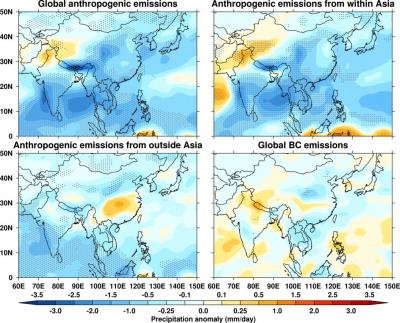Pollution Weakens Monsoon's Might: Local, Global Emissions Suppress South Asian Summer Rainfall
Over 1.5 billion people in South Asia depend on the summer monsoon rains. Now, pollution exhaust threatens this primary water source for crops and daily living, according to new research at DOE's Pacific Northwest National Laboratory. Researchers found that pollution spewed from local and remote sources such as motorcycles and coal-fired power plants reduce summer monsoon rainfall in South Asia. Such pollution increases cloud cover to cool the Earth’s surface, reduces evaporation and, in turn, slows the momentum of air current bands that drive the global climate. This research was published in the Journal of Geophysical Research-Atmospheres.
PNNL researchers used the Community Earth System Model with coupled atmosphere, slab-ocean, sea ice, and land model components to study the effect of human-caused pollution particles on the South Asian summer monsoon. This three-dimensional global climate model used a key atmospheric component called the Community Atmosphere Model for a fully predictive aerosol life cycle. The researchers performed simulations of the climate in response to changes in aerosol particle emissions from pre-industrial to the present day based on emission datasets prepared for global climate model simulations that will be used by the forthcoming Intergovernmental Panel on Climate Change 5th Assessment report. The team looked at the thermal, radiative, dynamical, and hydrological climate responses to pollution’s effects on the monsoon. Separating out contributions of local versus non-local emissions, they found that local aerosols affect rainfall in the initial stages of the monsoon. Aerosols from Eastern Europe, the Middle East, and Africa are more important later in the summer. Comparing regional differences of aerosols over the continent, the researchers found slight increases in rainfall over the northwestern region due to a decrease in local forest and grass fires. Their results also showed that overall monsoon rainfall was not very sensitive to changes in carbon-containing aerosol particles based on current emission datasets. While there are some atmospheric heating effects from soot particles, ultimately the surface cooling caused by fossil-fuel emissions-based aerosols, including soot particles and aerosol-induced changes in clouds, dominated during the monsoon season to slow down the atmospheric circulation and reduce monsoon rainfall.
One-fifth of the world’s population calls South Asia home. The summer monsoon rainfall is a major source of fresh water for crops and groundwater reserves, and is a vital life source for the region’s people. On a global scale, the monsoons are a major source of energy driving the planet’s atmospheric circulation, which can affect the wheat crops in Kansas, as well as the rice fields in India. Increasing industrialization and population growth in South Asia means more human-caused pollution, the major source of emissions in this study. This research points to pollution’s ultimate effects on food and water supplies around the globe. “We found that increased local and remote pollution sources slow the monsoon circulation and suppress summer rainfall,” said Dr. Dilip Ganguly, atmospheric scientist at PNNL and lead author of the study. “This will have untold impacts on the global climate, ultimately affecting the precipitation patterns for the entire planet.”
Over 1.5 billion people in South Asia depend on the summer monsoon rains. Now, pollution exhaust threatens this primary water source for crops and daily living, according to new research by DOE scientists at Pacific Northwest National Laboratory. Researchers found that pollution spewed from local and remote sources such as motorcycles and coal-fired power plants reduce summer monsoon rainfall in South Asia. Such pollution increases cloud cover to cool the Earth’s surface, reduces evaporation and, in turn, slows the momentum of air current bands that drive the global climate. PNNL researchers used the Community Earth System Model with coupled atmosphere, slab-ocean, sea ice, and land model components to study the effect of human-caused pollution particles on the South Asian summer monsoon. This three-dimensional global climate model used a key atmospheric component called the Community Atmosphere Model for a fully predictive aerosol life cycle. The researchers performed simulations of the climate in response to changes in aerosol particle emissions from pre-industrial to the present day based on emission datasets prepared for global climate model simulations that will be used by the forthcoming Intergovernmental Panel on Climate Change 5th Assessment report. The team looked at the thermal, radiative, dynamical, and hydrological climate responses to pollution’s effects on the monsoon. Separating out contributions of local versus non-local emissions, they found that local aerosols affect rainfall in the initial stages of the monsoon. Aerosols from Eastern Europe, the Middle-East, and Africa are more important later in the summer. Their results also showed that overall monsoon rainfall was not very sensitive to changes in carbon-containing aerosol particles based on current emission datasets. While there are some atmospheric heating effects from soot particles, ultimately the surface cooling caused by fossil-fuel emissions-based aerosols, including soot particles and aerosol-induced changes in clouds, dominated during the monsoon season to slow down the atmospheric circulation and reduce monsoon rainfall.
This research was supported by the U.S. Department of Energy’s (DOE’s) Office of Science Biological and Environmental Research (BER) Earth System Model Development Program (ESMD). The research was performed by Drs. Dilip Ganguly, Philip J. Rasch, Hailong Wang, and Jin-Ho Yoon of PNNL. They used the computing resources at the DOE’s National Energy Research Scientific Computing Center (NERSC).

